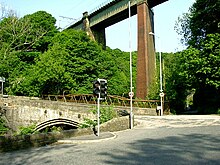Broadbottom Viaduct
| Broadbottom Viaduct | |
|---|---|

The central section, showing one of the original stone piers and one of the 20th-century red brick intermediate piers
|
|
| Coordinates | 53°26′27″N 2°00′24″W / 53.440794°N 2.006548°WCoordinates: 53°26′27″N 2°00′24″W / 53.440794°N 2.006548°W |
| Carries | Glossop Line |
| Crosses | River Etherow |
| Locale |
Broadbottom, Greater Manchester, England grid reference SJ997938 |
| Other name(s) | Etherow Arches |
| Maintained by | Network Rail |
| Heritage status | Grade II listed |
| Characteristics | |
| Total length | 169 yards (155 meters) |
| Height | 136 feet (41 meters) |
| History | |
| Architect | A.S. Jee |
| Designer | Joseph Locke |
| Opened | 1842 |
Broadbottom Viaduct (also known as Etherow Viaduct) is a railway viaduct that spans the River Etherow between Derbyshire and Greater Manchester in England. Originally of wooden construction supported by stone piers, the timber was replaced first with wrought iron girders, less than 20 years after the viaduct's opening, and later with riveted steel girders. It is a Grade II listed building.
Broadbottom Viaduct is one of two similar viaducts 1.5 miles (2.4 kilometres) apart (the other being the much longer Dinting Viaduct) on the Glossop Line, which connects several villages in north-west Derbyshire with Manchester Piccadilly station. Both viaducts are significant for their height and the distance between their columns. Broadbottom is 137 feet (42 metres) high, 169 yards (155 metres) long, and has three main spans, which carry the railway over a gorge formed by the River Etherow.
The viaduct was completed in 1842, built by Joseph Locke and A.S. Jee for the Sheffield, Ashton-under-Lyne and Manchester Railway.
The viaduct itself was originally of a laminated timber construction with three arches, each having three ribs, of which the middle rib was considerably heavier than the other two. The timberwork deteriorated, and was replaced with hollow wrought iron plate girders which were fabricated on-site by contractors William Fairbairn & Sons while the viaduct continued in use. The girders were carried onto the bridge on bogies before being lowered onto the existing supporting piers, built from locally quarried stone. The work was completed by the end of 1859 after a little over six months; similar work carried out on Dinting Viaduct was completed in 1860, having had minimal effect on train services. Railway historian Gordon Biddle described the wrought iron construction as "less majestic" than the original, but "still impressive".
...
Wikipedia
